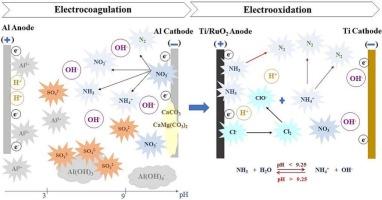Enhancement of Tunisian groundwater treatment through the simultaneous removal of sulfate, nitrate and nitrogen by-products using a hybrid electrochemical process
IF 6.3
2区 工程技术
Q1 ENGINEERING, CHEMICAL
引用次数: 0
Abstract
Combined electrocoagulation (EC) and electrooxidation (EO) process was applied to increase Tunisia's drinking water potential from a highly sulfate and nitrate contaminated groundwater. Firstly, batch EC experiments were carried out using Al electrodes under current density (7.2 to 59.5 mA cm−2), initial pH (3.0 to 11.0), and temperature (10.0 to 50.0 °C). The results showed that high removal efficiencies, 83.2 % and 82.1 % for sulfate and nitrate, respectively, were achieved at 42.8 mA cm−2, initial pH 7.0, and 30.0 °C, while excessive amounts of 0.4 mg NO2−_N L−1 and 11.6 mg NH4+_N L−1 were produced. The mechanism study revealed that, at ambient temperature (20–30 °C), sulfate removal by adsorption on Al hydroxides was dependent of generated amount of hydroxide anions resulting from nitrate reduction into nitrogen by-products on the cathode. In second step, EO using a novel electrodes' combination (Ti/RuO2 anode and Ti cathode), under current density (7.5 to 30.0 mA cm−2), initial pH (8.5, 10.0), and initial temperature (10.0 to 50.0 °C), was implemented. The optimized conditions were found at 15.0 mA cm−2, initial pH 8.5, and 20.0 °C, leading to complete removal of NO2− and NH4+ in the form of N2 in <20 min.

利用混合电化学工艺同时去除硫酸盐、硝酸盐和氮副产物,加强突尼斯地下水处理能力
为提高突尼斯受硫酸盐和硝酸盐严重污染的地下水的饮用水潜力,采用了电凝聚(EC)和电氧化(EO)相结合的工艺。首先,在电流密度(7.2 至 59.5 mA cm-2)、初始 pH 值(3.0 至 11.0)和温度(10.0 至 50.0 °C)条件下,使用铝电极进行了批量电凝实验。结果表明,在电流密度为 42.8 mA cm-2、初始 pH 值为 7.0、温度为 30.0 ℃ 的条件下,硫酸盐和硝酸盐的去除率较高,分别为 83.2 % 和 82.1 %,同时产生了过量的 0.4 mg NO2-_N L-1 和 11.6 mg NH4+_N L-1。机理研究表明,在环境温度(20-30 °C)下,通过吸附在氢氧化铝上去除硫酸盐取决于阴极上硝酸盐还原成氮气副产物所产生的氢氧根阴离子的数量。第二步,在电流密度(7.5 至 30.0 mA cm-2)、初始 pH 值(8.5、10.0)和初始温度(10.0 至 50.0 °C)条件下,使用新型电极组合(Ti/RuO2 阳极和 Ti 阴极)进行环氧乙烷氧化。最佳条件为 15.0 mA cm-2、初始 pH 值 8.5 和 20.0 °C,可在 20 分钟内以 N2 的形式完全去除 NO2- 和 NH4+。
本文章由计算机程序翻译,如有差异,请以英文原文为准。
求助全文
约1分钟内获得全文
求助全文
来源期刊

Journal of water process engineering
Biochemistry, Genetics and Molecular Biology-Biotechnology
CiteScore
10.70
自引率
8.60%
发文量
846
审稿时长
24 days
期刊介绍:
The Journal of Water Process Engineering aims to publish refereed, high-quality research papers with significant novelty and impact in all areas of the engineering of water and wastewater processing . Papers on advanced and novel treatment processes and technologies are particularly welcome. The Journal considers papers in areas such as nanotechnology and biotechnology applications in water, novel oxidation and separation processes, membrane processes (except those for desalination) , catalytic processes for the removal of water contaminants, sustainable processes, water reuse and recycling, water use and wastewater minimization, integrated/hybrid technology, process modeling of water treatment and novel treatment processes. Submissions on the subject of adsorbents, including standard measurements of adsorption kinetics and equilibrium will only be considered if there is a genuine case for novelty and contribution, for example highly novel, sustainable adsorbents and their use: papers on activated carbon-type materials derived from natural matter, or surfactant-modified clays and related minerals, would not fulfil this criterion. The Journal particularly welcomes contributions involving environmentally, economically and socially sustainable technology for water treatment, including those which are energy-efficient, with minimal or no chemical consumption, and capable of water recycling and reuse that minimizes the direct disposal of wastewater to the aquatic environment. Papers that describe novel ideas for solving issues related to water quality and availability are also welcome, as are those that show the transfer of techniques from other disciplines. The Journal will consider papers dealing with processes for various water matrices including drinking water (except desalination), domestic, urban and industrial wastewaters, in addition to their residues. It is expected that the journal will be of particular relevance to chemical and process engineers working in the field. The Journal welcomes Full Text papers, Short Communications, State-of-the-Art Reviews and Letters to Editors and Case Studies
 求助内容:
求助内容: 应助结果提醒方式:
应助结果提醒方式:


